Human Orbital Spaceflights
![]()
International Flight No. 207STS-88Endeavour (13)93rd Space Shuttle missionUSA |
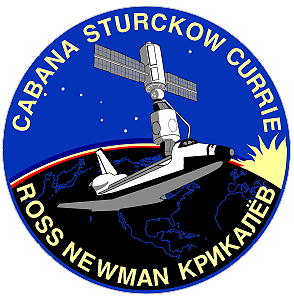 |
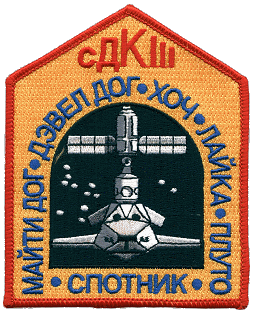 |
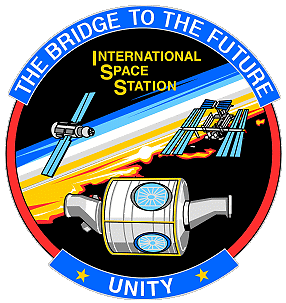 |
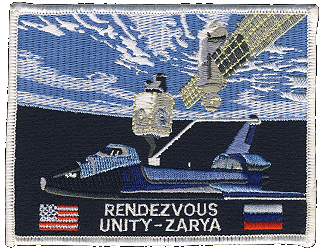 |
|
![]()
Launch, orbit and landing data
walkout photo |
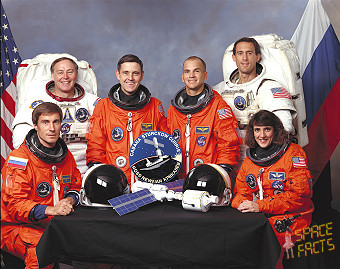 |
|||||||||||||||||||||||||||||||||
alternative crew photo |
alternative crew photo |
|||||||||||||||||||||||||||||||||
alternative crew photo |
||||||||||||||||||||||||||||||||||
alternative crew photo |
||||||||||||||||||||||||||||||||||
Crew
| No. | Surname | Given names | Position | Flight No. | Duration | Orbits | |
| 1 | Cabana | Robert Donald | CDR | 4 | 11d 19h 17m 54s | 185 | |
| 2 | Sturckow | Frederick Wilford "Rick" | PLT | 1 | 11d 19h 17m 54s | 185 | |
| 3 | Ross | Jerry Lynn | MS-1, PLC, EV-1 | 6 | 11d 19h 17m 54s | 185 | |
| 4 | Currie | Nancy Jane Sherlock | MS-2, RMS, FE | 3 | 11d 19h 17m 54s | 185 | |
| 5 | Newman | James Hansen | MS-3, EV-2 | 3 | 11d 19h 17m 54s | 185 | |
| 6 | Krikalyov | Sergei Konstantinovich | MS-4 | 4 | 11d 19h 17m 54s | 185 |
Crew seating arrangement
|
 |
|
||||||||||||||||||||||||||||
Hardware
| Orbiter : | OV-105 (13.) |
| SSME (1 / 2 / 3): | 2050-2A (1.) / 2044-2A (2.) / 2041-1 (5.) |
| SRB: | BI-095 / RSRM 67 |
| ET: | ET-97 (SLWT-3) |
| OMS Pod: | Left Pod 04 (20.) / Right Pod 01 (27.) |
| FWD RCS Pod: | FRC 5 (13.) |
| RMS: | 202 (3.) |
| EMU: | EMU No. 3015 (PLSS No. 1015) / EMU No. 3013 (PLSS No. 1013) / EMU No. 3006 (PLSS No. 1006) |
Flight
|
Launch from Cape Canaveral (KSC) and
landing on Cape Canaveral (KSC), Runway 15. The originally scheduled launch of Endeavour on December 03, 1998 was postponed for 24 hours when time ran out on the launch window. About 4 minutes prior to launch after orbiter hydraulic systems were powered on, a master alarm associated with hydraulic system number 1 in the crew cabin was noted. The countdown was held at T-31 seconds to further assess the situation. Shuttle system engineers attempted to quickly complete an assessment of the suspect hydraulic system and eventually gave an initial "go" to resume the countdown. With only seconds to respond, launch controllers were unable to resume the countdown in time to launch within the allotted remaining window. Space Shuttle mission STS-88, the 13th flight of the Space Shuttle Endeavour, began the largest international cooperative space venture in history as it attached together in orbit the first two modules of the International Space Station. STS-88 carried out the first USA Space Station Assembly Flight (ISS-01-2A). The U.S. built Node (Unity) docked with the Russian built FGB (Zarya). Zarya was boosted into orbit by a Russian Proton rocket on November 20, 1998 from the Baikonur Cosmodrome in Kazakhstan. Funded by the U.S. but built in Russia, Zarya will act as a type of space tugboat for the early station, providing propulsion, power, communications and the capability to perform an automated rendezvous and docking with the third module, the Russian-provided Service Module, an early living quarter. After Zarya achieved orbit, it awaited the arrival of Endeavour and Unity. Unity will serve as the main connecting point for later U.S. station modules and components. The first U.S.-built component of the International Space Station, a six-sided connecting module and passageway, or node, named Unity, was the primary cargo of Space Shuttle mission STS-88, the first mission dedicated to assembly of the station. The Unity connecting module, technically referred to as node 1, is a foundation for all future U.S. International Space Station modules with six berthing ports, one on each side, to which future modules will be attached. Built by The Boeing Company at a manufacturing facility at the Marshall Space Flight Center in Huntsville, Alabama, Unity is the first of three such connecting modules that will be built for the station. Sometimes referred to as Node 1, the Unity module measures 15 feet (4.57 meters) in diameter and 18 feet (5.49 meters) long. Carried to orbit aboard the Space Shuttle Endeavour, Unity was mated with the already orbiting Zarya control module, or Functional Cargo Block (Russian acronym FGB), a U.S.-funded and Russian-built component that was been launched earlier aboard a Russian rocket from Kazakhstan. In addition to connecting to the Zarya module, Unity eventually provides attachment points for the U.S. laboratory module; Node 3; an early exterior framework, or truss for the station; an airlock; and a multi-windowed cupola. The Zarya, which means Sunrise when translated to English, is actually a U.S. component of the station that was built by the Khrunichev State Research and Production Space Center (KhSC), in Moscow, under a subcontract to The Boeing Co. for NASA. Zarya is providing orientation control, communications and electrical power while attached to Unity for several months before the launch of the third component, a Russian-provided crew living quarters and early station core known as the Service Module. The Service Module will enhance or replace many functions of the Zarya. Later in the station's assembly sequence, the Zarya module will be used primarily for its storage capacity and external fuel tanks. Zarya's solar arrays and six nickel-cadmium batteries can provide an average of 3 kilowatts of electrical power. Each of the two solar arrays is 35 feet (10.67 meters) long and 11 feet (3.35 meters) wide. Using the Russian Kurs system, the Zarya will perform an automated and remotely piloted rendezvous and docking with the Service Module in orbit. Its docking ports will accommodate Russian Soyuz piloted spacecraft and unpiloted Progress resupply spacecraft. The module has been modified to allow it to be refueled by a Progress vehicle docked to its down-facing port if necessary. The module's 16 fuel tanks combined can hold more than 6 tons of propellant. The attitude control system for the module includes 24 large steering jets and 12 small steering jets. Two large engines are available for reboosting the spacecraft and making major orbital changes. More than 50,000 mechanical items, 216 lines to carry fluids and gases, and 121 internal and external electrical cables using six miles of wire were installed in the Unity node. The detailed and complex hardware installation required more than 1,800 drawings. The node is made of aluminum. Two conical docking adapters were attached to each end of Unity prior to its launch aboard Endeavour. The adapters, called pressurized mating adapters (PMAs), allow the docking systems used by the Space Shuttle and by Russian modules to attach to the node's hatches and berthing mechanisms. One of the conical adapters attached Unity to the Zarya, while the other served as a docking port for the Space Shuttle. The Unity node with the two mating adapters attached, the configuration it will be in for launch, is about 36 feet (10.97 meters) long and weighs about 25,600 pounds (11,612 kg). Attached to the exterior of one of the pressurized mating adapters are computers, or multiplexer-demultiplexers (MDMs), which provided early command and control of the Unity node. Unity also was outfitted with an early communications system that allowed data, voice and low data rate video with Mission Control, Houston, to supplement Russian communications systems during the early station assembly activities. The Shuttle's rendezvous with Zarya began with the precisely timed launch of Endeavour. Periodically during the 48 hours following launch, a series of rendezvous maneuvers were performed by Robert Cabana and Frederick Sturckow to slowly close in on the orbiting Zarya. A day before the final rendezvous with Zarya, Nancy Currie used the Shuttle's robotic arm to lift Unity from its horizontal berth in the aft cargo bay and securely latch it vertically atop the Orbiter Docking System in the forward portion of the bay. The early approach to Zarya was similar to those flown by the Shuttle during dockings with the Russian Mir Space Station. As the Shuttle closed in on Zarya, Nancy Currie maneuvered the robotic arm to a position above the cargo bay, in place to latch onto the module. The final approach to the Zarya was flown manually by Robert Cabana, beginning about an hour before capture as he crossed about 600 feet (182.9 meters) directly beneath Zarya, crossing an imaginary line running from Zarya toward Earth called the "R-Bar", or radius vector. Robert Cabana then flew a half circle around Zarya, crossing the module's direction of travel, to again reach what is referred to the minus R-bar at a point about 250 feet (76.2 meters) directly above the module. Robert Cabana then moved down toward Zarya along the R-bar. Robert Cabana completed the rendezvous by placing the edge of Endeavour's payload bay within about 10 feet (3 meters) of Zarya, allowing Nancy Currie to capture the module with the arm and dock it on the Node's mating adapter. Because the view of the Zarya from the crew cabin windows was blocked by Unity, the final minutes of the rendezvous and capture were conducted by the crew using only television monitors and the assistance of the Orbiter Space Vision System, an optical alignment aid that has been extensively tested on Shuttle flights leading up to STS-88. The alignment system used the orbiter's closed-circuit television system's view of special markings on the Zarya module to create a precise maneuvering aid for the crew when a direct line of sight is unavailable. To mate Zarya and Unity, Nancy Currie precisely positioned Zarya's docking mechanism above and adjacent to the mechanism on Unity. Then, as she put the arm in a "limp" mode that allowed movement, Robert Cabana fired Endeavour's thrusters to force the mechanisms together, similar to operations done earlier in the flight to dock Unity to the shuttle's docking mechanism. Jerry Ross and James Newman performed then two EVAs on December 07, 1998 (7h 21m) and December 09, 1998 (7h 02m) to connect cables and data transmission cables between the Node and Zarya. The first spacewalk consisted primarily of attaching umbilicals and connectors between the mating adapters, Unity and Zarya. Jerry Ross and James Newman began by setting up the Shuttle payload bay and worksites for the three spacewalks. A slidewire was installed for safety and to provide clearance while the spacewalkers connect umbilicals between the first mating adapter and Unity. Eight umbilicals were connected, four primary and four backups. Following the umbilical connections, Jerry Ross and James Newman removed thermal covers from the exterior computers, called multiplexer-demultiplexers (MDMs), on Unity. In addition, the spacewalkers installed six handrails, a task from the second spacewalk. Command checks between Mission Control, Houston, and Mission Control, Moscow, were conducted the next day, day six of the flight, while the crew pressurized the Orbiter Docking System vestibule, completed leak checks and prepared S-band communications equipment for installation on the second spacewalk. The ground control checks included verifying the ability to command Zarya from Houston via the Moscow control center. The mating adapter attached to the Zarya was pressurized via remote commands and checked for leaks. Filters and fans in Unity and Zarya were powered on as well. On the second spacewalk the two astronauts installed antennas on the port and starboard hatches of Unity for an S-band early communications system as well as a cable for that communications system that ran to the Zarya. Finally, a sunshade for the MDM computers was installed as well as covers for the trunnion pins which latched Unity in the Shuttle cargo bay. The next day, flight day eight, the day before the final spacewalk, the crew entered Unity and Zarya through the Shuttle docking mechanism for the first time. Reflecting the international cooperation involved in building the largest space complex in history, Commander Robert Cabana and Russian Cosmonaut Sergei Krikalyov opened the hatch to the U.S.-built Unity connecting module and floated into the new station together. Once inside, portable fans and lights were installed along with additional components of the S-band early communications system that enables U.S. flight controllers to monitor the outpost's systems. The crew performed an early checkout of the early communications system, exterior components of which were installed by Jerry Ross and James Newman on the previous day. They also transferred spare equipment from Endeavour to the teleconference capability of the early communications system, conduct a photographic survey of the interior, and replace filters. The third and final EVA was performed by Jerry Ross and James Newman on December 12, 1998 (6h 59m) to check the connected cables und to test the SAFER. The two stowed tools on the side of Unity to prepare for the spacewalks on STS-96, the next mission to the ISS. Jerry Ross also freed another antenna on Zarya, similar to the one James Newman freed on EVA-2. The astronauts started out disconnecting a wiring harness on one of Unity's mating adapters and safely covering the connectors. Next, tool boxes were stowed on the outside of Unity for use by future assembly spacewalkers. Jerry Ross and James Newman then ventured to the far end of Zarya to install a handrail that could not installed on the module prior to launch due to the fairing that covers the module during liftoff. Near the end of the third spacewalk, Jerry Ross test fired the Simplified Aid for Extravehicular Activity Rescue jet backpack. The SAFER backpacks act as a type of space lifejacket, available for use by a crew member in the event they become untethered and need to fly back to the station. During an earlier flight test, on Shuttle mission STS-86, a valve failed and prevented the propulsion jets on the backpack from firing. The valve was redesigned and extensively tested on the ground, however this test, during which Jerry Ross remained tethered at all times, assisted in checking out the new design. After the final EVA, Pilot Frederick Sturckow depressurized the vestibule between Endeavour and PMA-2 to prepare for the undocking of the two spacecraft on Flight Day 11. Following the completion of assembly on flight day 11, Frederick Sturckow undocked from the newly assembled International Space Station and backed away above, in reverse of the final approach. Then, Frederick Sturckow performed a full-circle flyaround of the modules from a distance of about 450 feet (137.2 meters) for about an hour before firing thrusters to separate Endeavour from the vicinity. Other payloads on the STS-88 mission included the IMAX Cargo Bay Camera (ICBC), the Argentine Scientific Applications Satellite-S (SAC-A), the MightySat 1 Hitchhiker payload, the Space Experiment Module (SEM-07) and Getaway Special G-093 sponsored by the University of Michigan. The primary objectives of ICBC on STS-88 were to film the Node 1 installation onto the orbiter docking system (ODS), the functional cargo block (FGB) rendezvous, FGB docking, extravehicular activity (EVA) tasks, separation burn, and flyaround. The ICBC was a space-qualified, 65 mm color motion picture camera system consisting of a camera, lens assembly, and a film supply magazine containing approximately 3,500 feet (1,067 meters) of film and an empty take-up magazine. The camera was housed in an insulated, pressurized enclosure with a movable lens window cover. The optical centerline of the 30 mm camera lens was fixed and points directly out of the payload bay along the orbiter Z-axis with a 23-degree rotation toward the orbiter nose. Heaters and thermal blankets provided proper thermal conditioning for the camera electronics, camera window, and film magazines. The MightySat 1 payload consisted of a nonrecoverable all-composite spacecraft structure and experiments integrated with a Hitchhiker (HH) ejection system (HES), then mounted inside a lidless carrier. The HH equipment consisted of one HH lightweight avionics plate (LAP), the HH avionics, one 5-cubic-foot (0.14 cubic meter) HH canister, and one HH adapter beam assembly (ABA). The payload was mounted in the orbiter bay 6 port location on a GSFC-provided HH ABA, with the MightySat 1 canister mounted in the forward position and the HH avionics mounted in the aft position. After the payload bay doors were opened, the crew activated the power and signal path to the HH carrier via the standard switch panel. The satellite was ejected from the HH canister on Flight Day 12. MightySat 1 remained in a dormant state until following ejection from the orbiter cargo bay. MightySat 1 was spring-ejected at a minimum rate of 1.7 fps (0.5 meter per second) and required an overflight of a specific location in Albuquerque, N.M. within 6 hours of deploy. Once ejection was complete, flight operations were complete for the satellite. Telemetry and command capability then were via the Payload Operations Control Center (POCC) at GSFC. The SAC-A payload consisted of the SAC-A installed in a Hitchhiker (HH) canister equipped with an HH ejection system and an HH motorized door assembly (HMDA). SAC-A was mounted in the forward position on an adapter beam, which was attached to the side wall of the orbiter in the Bay 2 port location. The satellite power was not applied until the flight crew opened the HMDA. As the HMDA opened, a switch on top of the satellite engaged, and power from the satellite batteries was applied to a single momentum wheel. The satellite was ejected after a minimum of 3 minutes to provide time for the momentum wheel to reach its operating speed. SAC-A was deployed from a near-circular orbit with an inclination greater than 38°. It required a postejection mean orbit height of 200 nautical miles (370.4 km). The end of SAC-A orbital operational lifetime occurred at 135 nautical miles (250 km). The Space Experiment Module (SEM) program was an educational initiative to increase student access to space. Kindergarten through University students were represented. The SEM-07 utilized a standard 5 cubic-foot GAS canister with a Goddard Space Flight Center (GSFC)-provided internal support structure, battery, power distribution system, data sampling and storage devices, and harness. It was mounted on an SSP/JSC-provided adaptor beam in Bay 13, port side, forward position. SEM-07 was PASSIVE. There were no batteries or power supplied by the Orbiter. |
EVA data
| Name | Start | End | Duration | Mission | Airlock | Suit | |
| EVA | Ross, Jerry | 07.12.1998, 22:10 UTC | 08.12.1998, 05:31 UTC | 7h 21m | STS-88 | Endeavour - ISS | EMU No. 3015 |
| EVA | Newman, James | 07.12.1998, 22:10 UTC | 08.12.1998, 05:31 UTC | 7h 21m | STS-88 | Endeavour - ISS | EMU No. 3013 |
| EVA | Newman, James | 09.12.1998, 20:33 UTC | 10.12.1998, 03:35 UTC | 7h 02m | STS-88 | Endeavour - ISS | EMU No. 3013 |
| EVA | Ross, Jerry | 09.12.1998, 20:33 UTC | 10.12.1998, 03:35 UTC | 7h 02m | STS-88 | Endeavour - ISS | EMU No. 3015 |
| EVA | Ross, Jerry | 12.12.1998, 20:33 UTC | 13.12.1998, 03:32 UTC | 6h 59m | STS-88 | Endeavour - ISS | EMU No. 3015 |
| EVA | Newman, James | 12.12.1998, 20:33 UTC | 13.12.1998, 03:32 UTC | 6h 59m | STS-88 | Endeavour - ISS | EMU No. 3013 |
Photos / Graphics
 |
 |
 |
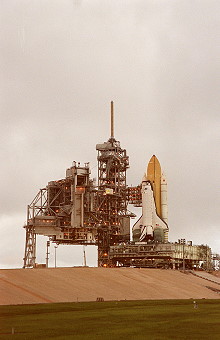 |
 |
 |
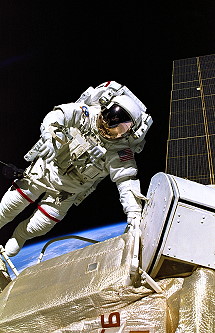 |
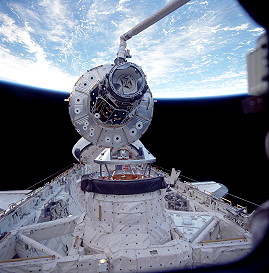 |
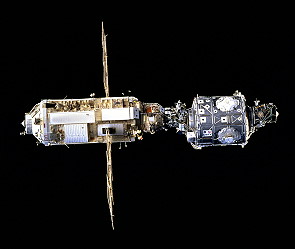 |
 |
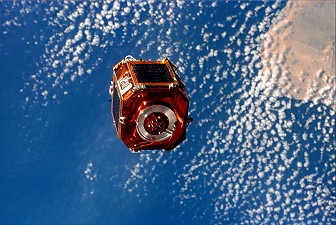 |
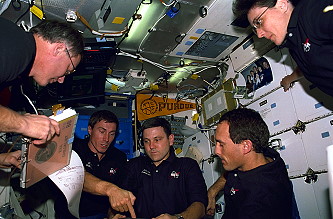 |
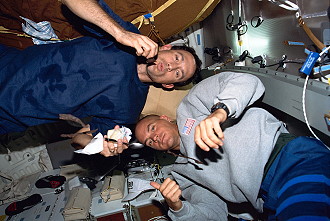 |
 |
 |
|
more EVA photos |
|
| © |  |
Last update on March 27, 2020.  |
 |